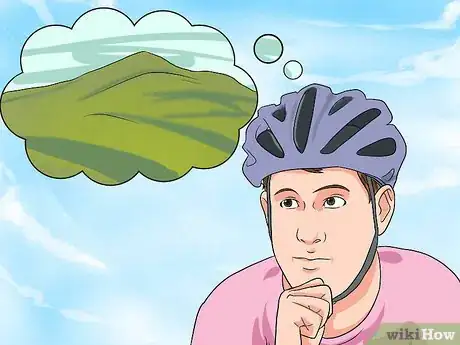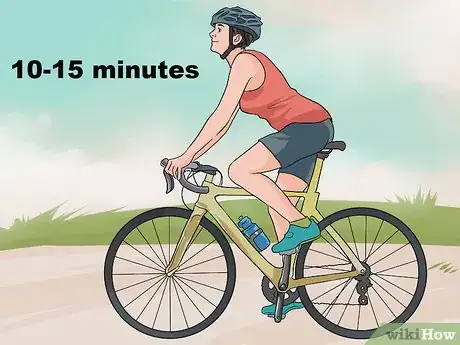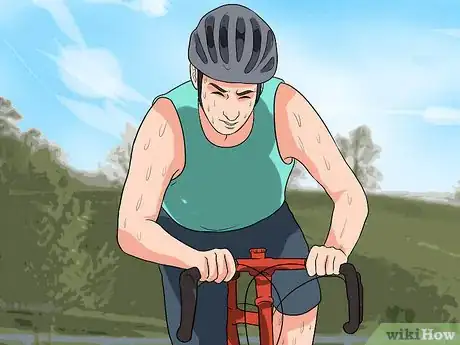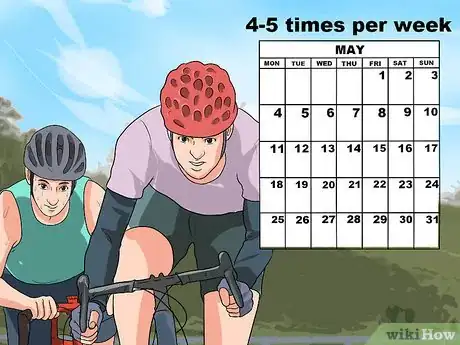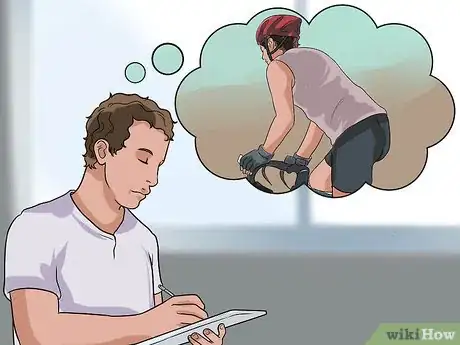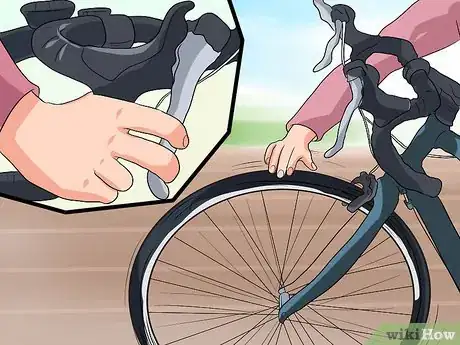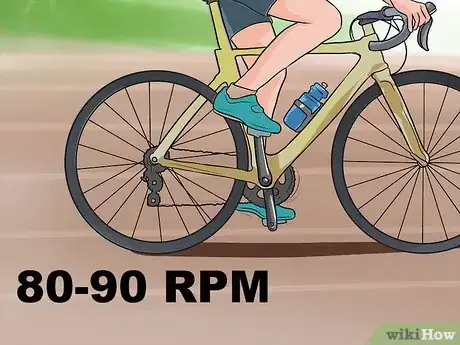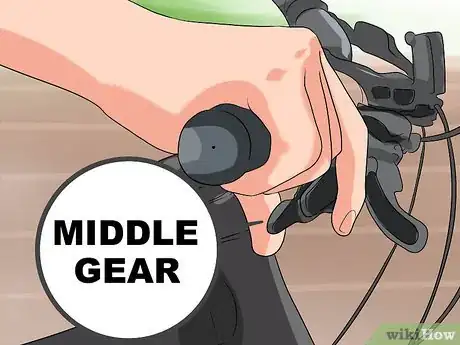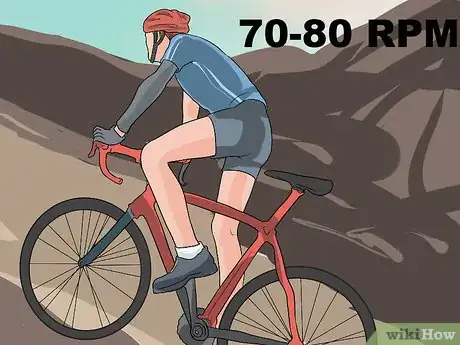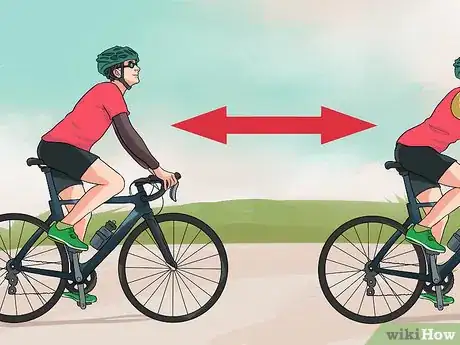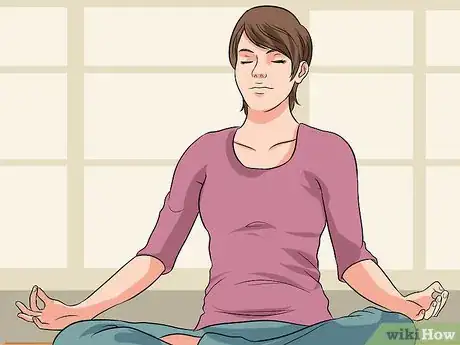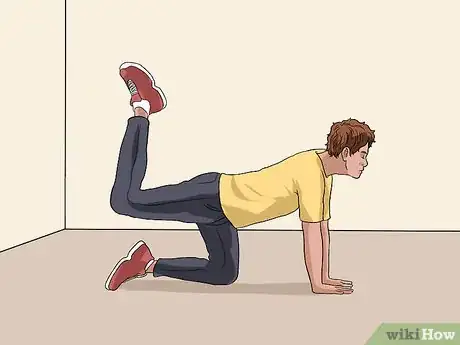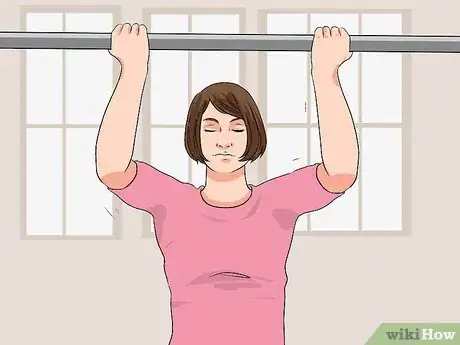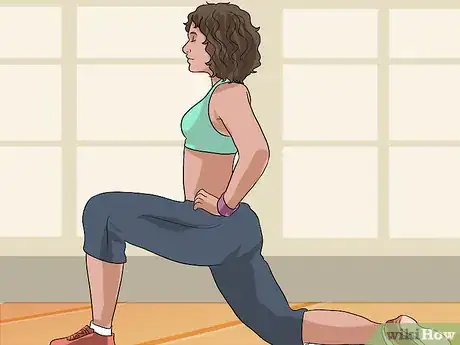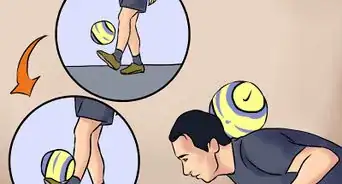This article was co-authored by Jonas Jackel. Jonas Jackel is the Owner of Huckleberry Bicycles, a bicycle retail store based in San Francisco, California. Jonas has over 20 years of experience managing bicycle retail stores and has operated Huckleberry Bicycles since 2011. Huckleberry Bicycles specializes in servicing, repairing, and custom building road, cross, gravel, touring, folding, and e-bikes. Jonas was also previously sat on the Board of Directors for Bike East Bay, a bicycle-advocacy non-profit organization based in Oakland, California.
There are 11 references cited in this article, which can be found at the bottom of the page.
This article has been viewed 32,565 times.
Being a better cyclist, at the end of the day, is riding more. But with some persistence and thoughtful training, you can make the most of your weekly rides -- and off time -- to grow stronger and faster in no time.
Steps
Improving Endurance and Power
-
1Determine your ultimate goals as a cyclist. Are you looking to improve up hills? Do you want to compete in races? Do you want to ride longer distances? Knowing your end goals will help you make a specific training program, which will cut into your weaknesses much faster than just going out and riding randomly. [1] For example:
- If you want to be a better climber, you need to design rides/routes that feature a lot of elevation change.
- If you want to compete in a race, you need to build your overall speed and strength, favoring shorter, but faster, rides and minute adjustments meant to shave off seconds.
- If you want to ride for longer, you need to slowly build up your endurance, increasing your mileage each week.[2]
-
2Try interval training to build endurance and strength quickly. Endurance training is when you push yourself nearly to the max for 1-2 minutes, then slow down to rest for 1-2 minutes. By repeating this multiple times, you train your heart and body to push itself and then recover quickly, which translates into better cycling overall. While there are hundreds of interval routines out there, start out simple:
- Warm up at a slow, even pace for 10-15 minutes.
- Push yourself for 1 minute at 80-90% top speed.
- Relax to a slow, even pace for 2 minutes.
- Repeat 5 more times.
- Cool down for 10-15 minutes at a slow, even pace.
- As you improve, lower your rest time by 15 seconds each ride.[3]
Advertisement -
3Seek out the hills. Hills may not be fun in the moment, but they are nature's way of whipping you into shape. Focus on hill riding 2-3 times a week, and push yourself up them. You can even time yourself up hills you tackle commonly, then race against your best times as you get stronger.
- Try cranking up hills one gear higher than you normally would, and stay seated throughout. You'll go slower, but the training will be incredible.[4]
-
4Ride your first century, or 100-mile ride. The century is more than a rite of passage, it is a great way to train your body for longer, more grueling rides. That said, there is a wide variety of ways to conquer a century, from all-out pushes to slower rides with frequent stops for food and stretching. No matter your speed, a century ride will push you mentally and physically into a better rider, making your next 20-mile loop feel like a breeze.[5]
-
5Ride 4-5 times a week. At the end of the day, the only guaranteed way to become a better cyclist is to get out and ride every week. No matter where you go, or the speed you go, the more miles you log the faster you will be. Even riding to and from work, however short, will help you make slight gains.
- Mix up your routes - this not only keeps riding interesting, it presents new kinds of challenges and terrain.
- Time yourself or get a bike computer for detailed information on your average speed, time, and miles covered.
- Join group rides or ride with friends for added incentive. Try and find riders that challenge you to go faster and get stronger.[6]
-
6Create a training schedule to maximize your workouts. Having a schedule makes it easier to stick to your goals and get the most out of your rides. The schedule does not have to be super complex, and there are only a few rules that you need to abide by:
- Schedule two days in between major or difficult rides, like interval training or an extra-hilly day. Your legs need time to recover.
- Give yourself 1-2 long, slow rides. This builds overall endurance and helps your legs stay loose.
- Ramp up the total mileage by 10-12 miles each week if you're training for longer rides.
- Log each ride, time, and mileage to track your improvement.[7]
Conquering Difficult Rides
-
1Always do a pre-ride checklist to spot potential problems before they ruin a ride. A simple once-over on your bike should be enough. You should always be prepared for long rides with food, water, and a spare tube. If you don't know how to change a tire, practice one in the safety of your garage before heading out. Right before you get on your bike, check out:
- Wheels: Push your tires-- they should be firm. Grip the spokes and make sure they don't bend or feel loose. Spin them and make sure they don't rub against the brakes.
- Chain: Rub it with your finger -- a small amount of oil should come off. If not, you should clean and lube your chain. If there is any rust, it may be time for a new chain.[8]
- Brakes: Spin a wheel, then pull the brakes, making sure they stop the wheel instantly.[9]
-
2Keep your pedal speed consistent to learn proper shifting. In a perfect world, your feet will be moving at the exact same speed the entire ride, making the same number of revolutions per minute (RPMs) for the entire ride. While this isn't practical, nor advisable in a race, the general principle is the same -- you want to shift so that your feet keep moving freely, not speeding up and slowing down constantly. You'll save energy and keep a more consistent, even pace this way, which is essential over long rides.
- You want to aim for 80-90 RPM, meaning your foot makes one and a half full rotations every second.
- You want to shift before a hill gets difficult, shifting slowly so that your feet can keep moving at the same pace.[10]
-
3Descend fearlessly to maintain speed. Learning to descend a hill safely, but quickly, is essential to conserve momentum and shave minutes off of your time. Keep your body loose and relaxed to react quickly to turns or potholes. Grab the drop bars to decrease air resistance. If there are no turns coming, avoid braking -- you'll just lose speed you have to pedal to get back. If there is a turn:
- Brake to your comfortable speed before the turn comes -- you don't want to be slowing down as you hit it.
- Shift into a middle gear -- easy enough to pedal quickly but hard enough that you get some speed on the way out of the turn.
- Put some weight on the outside pedal (it should be down) and lean your body slightly into the turn. If you're nervous, practice this skill on flat turns first.
- Stand up and pedal hard out of the turn for 3-4 seconds to regain speed, then lower back to the drop bars.[11]
-
4Pace yourself wisely up climbs. You want to shift before the climb, just as it is getting difficult, to keep your legs pumping at an even, maintainable speed. You'll likely drop some RPMs, ending up around 70-80, but the goal is a consistent speed that doesn't immediately tire you out. You have the low gears for a reason -- you'll be faster sticking to one of them than trying to slog up in a heavy gear and shift later on.[12]
- There is nothing wrong with standing at the end of a climb -- it shifts the muscles you're using for a quick burst of power. Standing, however, is much more intense on your lungs than seated riding, so save it for the last push of the hill.
-
5Pay attention to your front wheel on group rides. Riding in a pack is a skill by itself, but all it really requires is careful attention. Only ride as close to another rider as you feel comfortable. On hills, either up or down, spread out into smaller clumps of 2-3 riders, minimizing the chance for massive, dramatic pile-ups.
- Always pay attention to your front wheel. If you want to chat and enjoy the scenery, give some distance or ride side-by-side.
- If you're near the front of a group, call out any potholes, sticks, or broken glass in advance and point out its location. Many riders behind you, especially those focused on your back wheel, won't see the dangers until it is too late if you aren't vocal.[13]
-
6Drink and eat like a pro by refueling while your ride. "Bonking," is the not-so-technical term for running out of energy mid-ride, and it hits many riders who don't come prepared. In general, you should have a full water bottle for every hour you're riding, and you should have some sort of snack if you plan on going longer than an hour and a half. If you're doing a long ride, have some food once or twice every hour and stop at gas stations to refill your bottles. Something with quick sugars, a little bit of protein, and a very little far is perfect, and sports drinks make good substitutes for shorter rides. Good, portable choices include:
- Apples and bananas.
- PBJ sandwich
- Bag of low-sugar cereal or granola.
- Packet of Fig Newtons, crackers, or pretzels.
- Energy bars, gels, and beans.[14]
Training Off the Bike
-
1Build your quads for pure cycling power. Your thighs are your pistons when riding. If you're going to build muscle outside of riding, this is the place to start. Try out:
- Squats
- Leg presses
- Agility ladder drills.
-
2Build up your core strength for smoother, stronger pedal strokes. Your core is where you transfer energy from your upper body to lower, and how you keep balanced. A strong core allows you to expend your energy only from your legs, minimizing wasteful rocking movements and keeping you moving forward. Incorporate:
- 2-300 crunches every other day.
- 3x 1-minute planks, on each side.
- Yoga.
- Ball and machine exercises.[15]
-
3Work your hamstrings. The hamstring/quad combo is the source of most of your cycling power. While quads build easily while riding, many professional riders find that dedicated hamstring workouts translate to better rides and faster splits. To build your hamstrings up, try:
-
4Work your back for better stability and safety in the event of a crash. Back exercises also target many core muscles, and will make you a better athlete overall. Try out:
-
5
Warnings
- Stay inside your comfort zone⧼thumbs_response⧽
- Don't go uncomfortably fast⧼thumbs_response⧽
References
- ↑ Jonas Jackel. Bicycle Shop Owner. Expert Interview. 18 February 2020.
- ↑ http://www.cyclingweekly.co.uk/fitness/training/seven-simple-steps-successful-cyclist-138915
- ↑ http://www.bicycling.com/training/bike-skills/it-gets-easier-cycling-advice-new-cyclists
- ↑ http://www.bikeradar.com/us/road/gear/article/10-steps-to-being-a-fitter-faster-better-cyclist-44603/
- ↑ http://www.bicycling.com/training/bike-skills/it-gets-easier-cycling-advice-new-cyclists
- ↑ http://triathlete-europe.competitor.com/2011/07/05/the-ten-golden-rules-to-becoming-a-better-cyclist
- ↑ http://home.trainingpeaks.com/blog/article/three-steps-to-becoming-a-better-cyclist
- ↑ Jonas Jackel. Bicycle Shop Owner. Expert Interview. 18 February 2020.
- ↑ http://www.bicycling.com/training/bike-skills/it-gets-easier-cycling-advice-new-cyclists
- ↑ http://www.bicycling.com/training/bike-skills/it-gets-easier-cycling-advice-new-cyclists
- ↑ http://www.bikeradar.com/us/road/gear/article/10-steps-to-being-a-fitter-faster-better-cyclist-44603/
- ↑ http://www.bicycling.com/training/bike-skills/it-gets-easier-cycling-advice-new-cyclists
- ↑ http://www.bikeradar.com/us/road/gear/article/10-steps-to-being-a-fitter-faster-better-cyclist-44603/
- ↑ http://www.bikeradar.com/us/road/gear/article/10-steps-to-being-a-fitter-faster-better-cyclist-44603/
- ↑ http://www.active.com/cycling/articles/10-cycling-tips-to-get-faster?page=3
- ↑ http://www.bodybuilding.com/exercises/finder/lookup/filter/muscle/id/8/muscle/hamstrings
- ↑ http://www.bodybuilding.com/exercises/finder/lookup/filter/muscle/id/14/muscle/glutes
About This Article
To become a better cyclist, try to ride 4-5 times a week, even if they're short rides, which will increase your speed and endurance. Also, devote 2-3 of your weekly rides to hill riding since it will help you get in shape faster. You can also try timing yourself when you're riding and then racing against your best time. In addition to riding more, you should do exercises off of your bike as well, like squats, leg curls, lunges, and pull-ups. To learn how to get better at difficult rides, scroll down!
